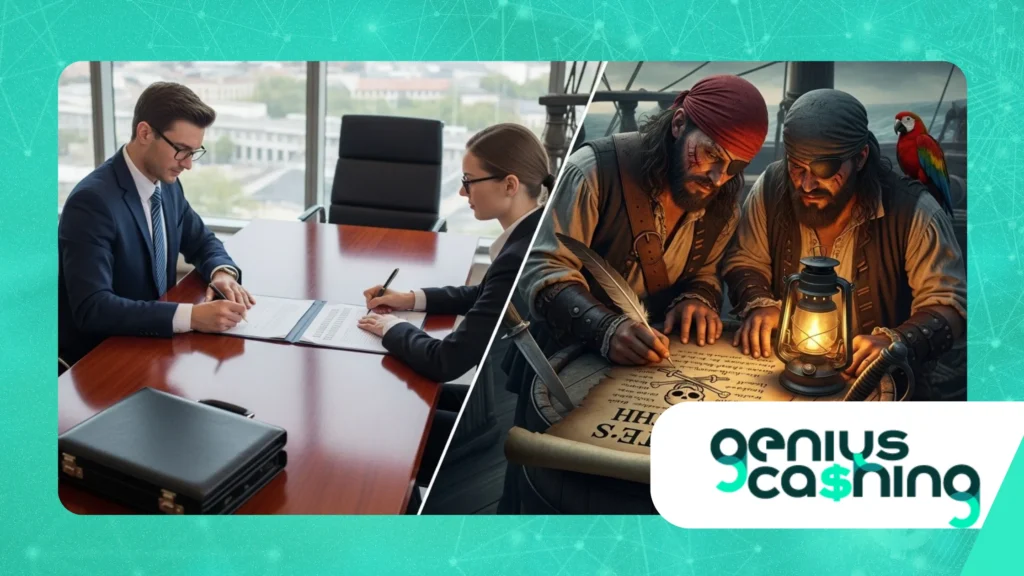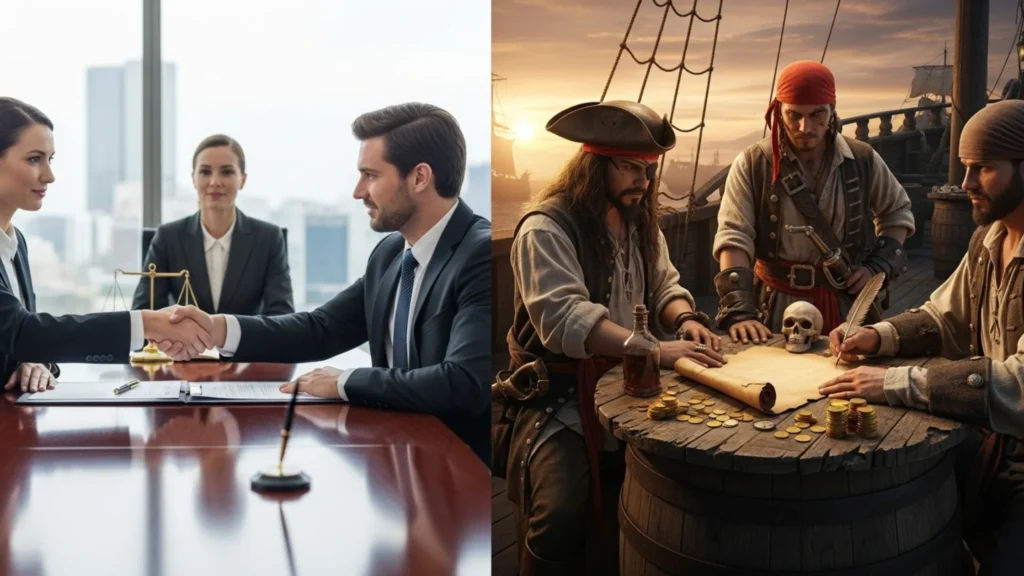The Curious Connection Between Pirates and Modern Corporate Law

Curious Connection Between Pirates and Modern Corporate Law a headline that seems like pure fantasy, yet hides a profound, unconventional truth about organizational design and risk management.
Anúncios
The swashbuckling buccaneers of the 17th and 18th centuries, operating beyond the reach of formal law, unexpectedly crafted governance structures that foreshadow key elements of today’s corporate agreements, shareholder democracy, and executive compensation.
They were not just marauders; they were pioneering social contractors.
This is not a tale of direct legal inheritance, but of parallel evolution driven by inescapable economic necessity.
Faced with extreme risk, the need for cooperation, and the absence of any external enforcement, pirates developed internal governance codes known as the “Articles of Agreement.”
Anúncios
These documents addressed profit-sharing, authority limits, and disability compensation issues central to any modern corporate charter or partnership agreement.
Their sophisticated approach to distributing risk and reward provides a fascinating, dark mirror to our current legal frameworks.
What Did Pirate “Articles of Agreement” Govern?
Pirate codes, such as those used by Captain Bartholomew Roberts, were essentially pre-incorporation agreements, signed and sworn to by every crew member.
These “Articles” were the foundation of their self-governance, a necessity because no legal authority would enforce contracts among criminals.
They sought to transform a “Rope of Sand” of individuals into a cohesive, functional, and profitable criminal enterprise.
These agreements explicitly dealt with matters of justice, discipline, and, most importantly, financial distribution. Every man understood his exact share of the plunder before the action began.
This transparency and pre-commitment to rules were critical for minimizing the internal conflicts that could quickly dissolve the operation.
++ The Island That Used 4-Ton Stones as Currency
How Did Pirates Implement Risk-Sharing and Compensation?
Pirates mastered risk-sharing in its purest form: no prey, no pay. Unlike salaried sailors on merchant vessels, pirates only earned when the collective enterprise succeeded, a concept strikingly similar to modern stock options or performance-based bonuses.
This aligns the incentives of every crew member directly with the profitability of the venture.
The Articles also included a detailed compensation scheme for work-related injuries, essentially an early form of workers’ compensation or insurance.
For instance, the loss of a right arm might be compensated with 600 pieces of eight (Source: Buccaneer history records, various Articles of Agreement).
This recognition of long-term risk provided crucial loyalty and ensured that men would fight aggressively, knowing their welfare was secured.
Also read: What the Titanic Can Teach You About Business Risk
What is the Historical Precedent for Executive Checks and Balances?
Pirate governance created a remarkable system of checks and balances to prevent the Captain from becoming an authoritarian dictator.
The Captain, though in charge during a chase or battle, was often elected and could be voted out by the crew a radical idea of direct democracy for the 18th century.
The Quartermaster, also an elected official, held power equal to or sometimes exceeding the Captain outside of combat, managing discipline and the division of spoils.
This duality of power is an analogical precursor to modern corporate boards checking the power of a CEO, ensuring accountability to the shareholders (the crew).

Why Did Pirate Democracy Resemble Shareholder Rights?
The core principle behind the Articles was the shared ownership of a highly volatile, high-risk venture. Every crew member, from the cook to the gunner, was essentially a stakeholder.
Their commitment was secured not by law, but by their contractual agreement and self-enforcement. This model of collective responsibility driven by contractual obligation is fundamental to partnership law.
This system effectively minimized internal predation pirates stealing from one another by making it a capital offense.
The crew’s collective interest in long-term success superseded individual greed, a principle modern corporate law aims to enforce through fiduciary duties and strong internal controls.
Read more: The Only Country That Ever Declared Bankruptcy 9 Times
How Did They Manage Executive Compensation and Authority?
The distribution of plunder, meticulously detailed in the Articles, mirrors modern executive compensation structures designed to incentivize leadership.
While the Captain received the largest share typically one and a half or two shares this was a measured bonus for taking on the highest combat risk and responsibility.
The Captain’s authority was constrained; he could not simply sail wherever he wished or hoard resources. Major decisions, known as “affairs of moment,” were often put to a vote, giving every man an equal say.
Doesn’t this sound familiar? It is the historical echo of “one share, one vote” in corporate governance, where shareholders have a democratic voice in company direction.
When deciding to pursue a particularly risky target, Captain Roberts’ crew would vote on the proposal.
This collective decision-making, where the risk-takers directly ratify the strategy, is paralleled today when a high-growth tech company’s board (representing the investors/shareholders) must approve a major acquisition proposed by the CEO (the Captain).
What Can We Learn About Risk from the Buccaneer Model?
Pirates operated in a true state of nature, where the risks were existential: capture, death, or starvation.
Their successful organization demonstrates that in high-risk environments, transparent governance and equitable profit-sharing are the only viable ways to ensure cohesion and maximize profit.
This is a critical lesson for today’s high-risk ventures, such as startups.
When a business relies heavily on the performance and dedication of a small, core team, the pirate model highlights the necessity of radical transparency in reward and immediate consequences for malfeasance.
The very existence of the “Articles” as a signed contract shows the value placed on clear, contractual relationships.
What is the Curious Connection Between Pirates and Modern Corporate Law’s Legacy?
The lasting significance of these pirate codes lies in their demonstration that effective governance does not require formal legal structures if incentives are perfectly aligned and risk is openly shared.
They were self-made contracts of cooperation in the ultimate high-risk, high-reward environment.
This self-governance model, developed under duress, became a living laboratory for concepts we now embed in complex legal frameworks.
Modern corporate law has merely codified and formalized these primal needs: the need for checks on executive power, transparent compensation, equitable profit-sharing, and a clear process for dispute resolution.
The pursuit of shared wealth required shared rules, whether on the high seas or in the high-rise offices of Manhattan.
Consider a modern startup scaling up quickly. They use vesting schedules and stock options to align employee incentives with company success, explicitly stating that employees receive shares only if they stay and the company grows.
This non-traditional risk/reward structure directly follows the pirate maxim: your share is dependent on your continued service and the collective success of the endeavor.
The historian Peter T. Leeson argues that the pirate democracy was a unique, real-world example of social contract theory (Source: The Calculus of Piratical Consent).
Is it not profoundly intriguing that the most notorious criminals of the sea implemented a form of constitutional democracy long before many nation-states?
| Injury Sustained (Example) | Compensation (Pieces of Eight) | Modern Corporate Parallel |
| Loss of Right Arm | 600 | Long-Term Disability / Worker’s Comp |
| Loss of an Eye | 100 | Supplemental Injury Benefits |
| Ordinary Seaman’s Share | 1 Share | Standard Employee Profit Sharing |
| Captain’s Share | 1.5 – 2 Shares | Executive Performance Bonus |
Conclusion: The Wisdom of the Outlaws
The Curious Connection Between Pirates and Modern Corporate Law reveals that organizational wisdom is often born out of necessity, not academia.
The buccaneers’ Articles of Agreement were not archaic curiosities; they were sophisticated, self-enforcing contracts designed for optimal performance under conditions of total uncertainty.
Their focus on elected leadership, constrained authority, and explicit risk-sharing is the economic blueprint underlying everything from corporate charters to VC partnership agreements.
The pirate legacy reminds us that the best corporate governance is simple, transparent, and built on perfectly aligned incentives.
It’s a fundamental principle that applies whether you’re chasing Spanish gold or chasing market share.
What other overlooked historical frameworks might be secretly shaping our modern business world? Share your experience in the comments below!
Frequently Asked Questions
Did the Founding Fathers Copy the Pirate Code for the US Constitution?
While some historians suggest parallels, particularly regarding elected officials and checks and balances, there is no direct evidence that the US Founding Fathers formally adopted the pirate codes.
The similarity suggests that the pirate structure was a pragmatic, natural response to creating democratic order among equals in a state of nature.
What does “Non-Dilutive” Mean in a Business Context?
In finance, “non-dilutive” refers to funding that does not require giving up equity or ownership in the company.
Although government grants are the most common example, the pirate’s “no prey, no pay” system was fundamentally non-dilutive the crew earned shares of the plunder (profit) but did not own shares of the ship (capital/company).
Was the Captain Always Elected?
In many of the most successful pirate operations, yes. Captains were often elected and held office based on performance.
Poor leaders, especially those deemed cowardly or cruel, could be and often were voted out by the crew. This “at-will” leadership is a stark contrast to the absolute authority found on contemporary merchant or naval ships.
How was Discipline Enforced without a Court System?
Discipline was enforced directly by the Quartermaster or via a jury of the crew, as stipulated in the Articles.
Punishments were severe and immediate, including flogging, splitting of ears/noses, or the ultimate penalty of marooning.
This harsh self-enforcement was necessary because appealing to any external authority (a government court) was impossible.
Where can I find a verified example of a Pirate Article?
One of the most famous and well-documented examples is the set of Articles associated with Captain Bartholomew Roberts, active in the early 18th century.
Details of his code were recorded in A General History of the Pyrates by Captain Charles Johnson (Daniel Defoe), and are widely cited by historians studying pirate governance.
